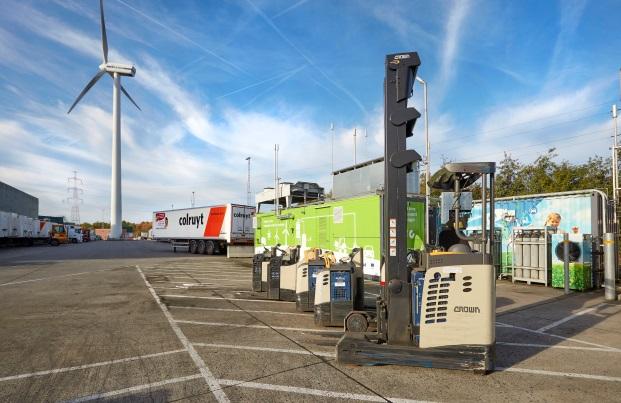
Hydrogen has the highest mass energy density of any fuel, making it an extremely effective medium for energy storage and distribution. As Europe deploys more renewable capacity, from vast wind farms to roof-top solar arrays, hydrogen is set to be an essential integrator, harnessing excess power generation, balancing intermittent supply and demand, and ultimately helping support a clean, efficient and sustainable energy system.
Wind and solar energy production increased by a record 6.3 % and 15 %respectively across Europe in 2015, but both sources still account for less than 20 % of all renewable production and around 5 % of total energy supply. Higher wind- and solar-power penetration is possible, but several challenges remain if production is to meet demand. One solution is electrical energy storage.
“A High-Renewables scenario of the European Commission’s Energy Roadmap 2050 aims for 85% of energy coming from renewable sources, with 65 %of it from stochastic sources such as wind and solar which generate energy intermittently. Meeting that target will result in a 10-fold increase in demand for energy storage ,” explains FCH JU project manager Nikolaos Lymperopoulos.
While a variety of technologies will be used to fulfill storage needs, hydrogen plays an essential role in different areas of the supply and distribution chain for renewably-sourced energy.
At wind and solar energy sites, excess electricity not supplied directly to the power grid can be used to perform electrolysis to split water molecules into oxygen and hydrogen, with the hydrogen stored for later reuse, ensuring that not a single kilowatt-hour is wasted. The hydrogen can be used directly as a clean-burning gas in power stations, pumped into the natural gas grid, reconverted into electricity using fuel cells, or used as a transport fuel for hydrogen fuel cell vehicles. Renewably sourced hydrogen can also help meet demand from metallurgical plants, refineries and electronics factories among other sectors looking to ‘green’ their industrial processes.
Out of 33 FCH JU projects related to hydrogen production,16 support the development of electrolysers for energy applications. Projects such as HPEM2GAS and ELY4OFF, for example, are researching hydrogen gas technologies for energy applications, both grid-connected and at standalone off-grid sites, while the SOPHIA initiative has developed production capacity for hydrogen in combination with carbon dioxide to create synthetic fuels.
Hydrogen produced from electrolysis can be kept as a gas under high pressure or as a liquid at very low temperature, while hydrogen’s stable chemistry also means it can hold energy longer than any other medium. Smaller amounts of hydrogen can be stored in above-ground tanks or pressurised bottles, while larger amounts can be pumped into the natural gas grid, even underground caves with a capacity of hundreds of thousands of cubic metres. Such large capacity storage has been evaluated by the HyUnder project, which assessed salt-cavern storage sites for renewably sourced hydrogen across Europe and looked at potential interactions with the transport sector and other markets.
Scalable renewable energy infrastructure
One of the biggest benefits of hydrogen is its scalability. A two-megawatt hydrogen electrolyser is roughly the size of a shipping container and can be easily installed next to a field of wind turbines or a distribution substation. This supports a wide variety of applications, including local and decentralised systems providing electricity and fuel for vehicles autonomous of other infrastructure except a clean water supply.
The Don Quichote project is testing the commercial viability of an integrated hydrogen storage system linked to a refuelling facility, directly connecting intermittent renewable electricity to transport applications. With a complete hydrogen-based energy system established at a commercial site near Brussels, the Don Quichote team is using electricity from solar panels and a wind turbine to generate hydrogen through electrolysis that is then used for back-up power supply and to refuel fuel cell-powered forklift trucks and other vehicles.
“We are applying new concepts and technologies to prove the commercial viability of hydrogen-based systems and reduce the cost of ownership,” explains Johan Seykens, the Don Quichote project coordinator at hydrogen energy firm Hydrogenics. “We have deployed a Proton Exchange Membrane (PEM) electrolyser, for example, which produces better quality hydrogen at a faster rate and overcomes some of the intermittency issues of wind and solar power generation.”
Another project, Hybalance, is also planning to use an advanced PEM electrolyser in a large demonstration initiative. Deployed in Denmark, the more than one megawatt-capacity electrolyser will produce hydrogen from renewable energy for an industrial client, supply electricity to the grid, and provide hydrogen to a network of five refuelling stations supporting more than 60 fuel cell vehicles.
While using electricity-producing wind and solar for electrolysis is the most mature technology for generating hydrogen from renewables, other methods of harnessing renewable energy sources are also being investigated.
The Hydrosol family of projects focused on producing hydrogen through the thermolysis of water, in which solar heat is used to break the chemical bonds between oxygen and hydrogen in water. Other projects such as ARTIPHYCTION and PECDEMO are working to achieve the same using light, a process known as photoelectrolysis.
Individually and in combination, all of these projects are making significant contributions to the development of renewable energy infrastructure supported by hydrogen.
Article source: European Commission, Research & Innovation Information center,read the full article here
Details
- Publication date
- 29 August 2016
